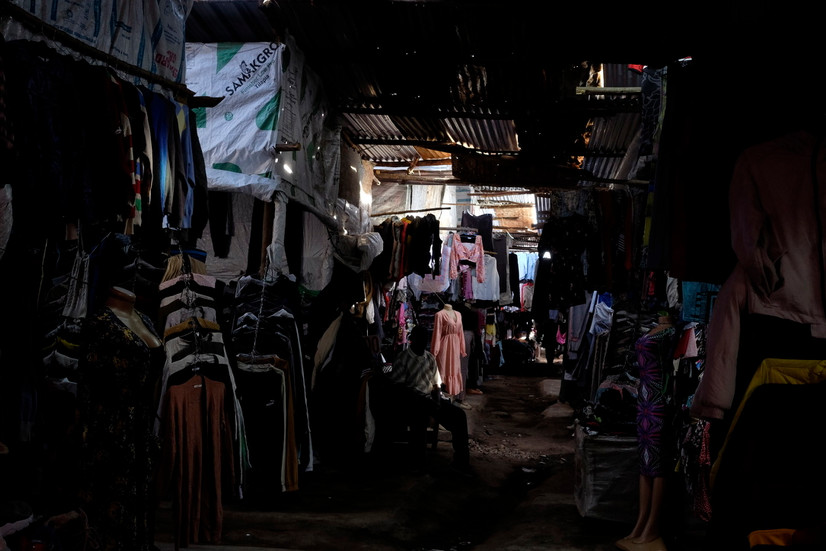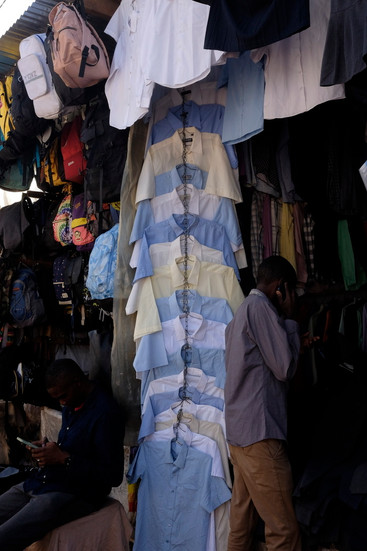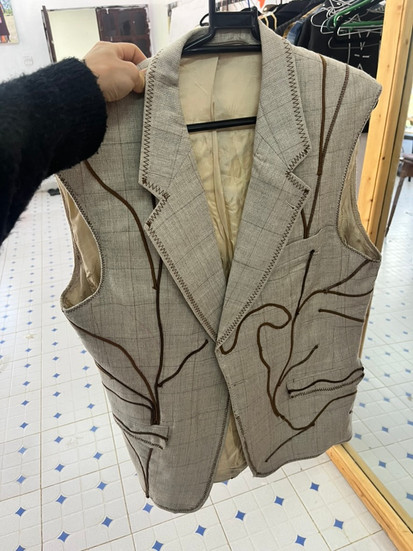Kenya’s Sustainable Fashion Industry: Challenges, Innovations, and examples of wonderful projects
- Virginia Rollando
- Feb 7
- 10 min read
Updated: Feb 9
Starting from the end of December, I had the incredible opportunity to travel around Kenya for a month. My brother is currently working there for UNEP (United Nations Environment Program), so I could combine family time, traveling around the country through stunning mountains, lakes, forests, natural reserves, and islands, and digging into the ins and outs of Kenya’s sustainable Fashion efforts.
I am extremely grateful to all the people who welcomed me and shared their stories. Although landscapes are incredible, encounters with people will always be the thing that remains in my memory the deepest after a trip, and this one is the ultimate proof. Kenya’s size and multitude of ethnicities make it an extremely diverse country, and it’s beautiful to see how people from different religions and backgrounds live in harmony.
Kenya is a vast country, so of course in one month I could only see parts of it, and I am sure that I have missed a lot of great examples. If you know of anything that should be included here, please don’t hesitate to share.

INTRO
The Kenyan fashion industry is at a very delicate stage of its evolution. The country is going through economic and environmental challenges, there are waves of political unrest, the last one in June, and a large proportion of its population is living in poor conditions. It is a country with a lot of extremes, Kenya's economy is very developed, which is clear from Nairobi’s high-rise buildings, fancy restaurants, and access to everything you could possibly need, however, 25% of Kenya’s population lives below the international poverty line.
Kenya plays a key role in Africa and the global economy, with the presence of various banks, the UN, and important corporations. It is being affected by all the challenges of a rapidly changing world, including climate change, and therefore the need to focus on sustainability, which is showing its signs in fashion as well. Locally, there is an emerging movement working tirelessly to reshape the industry through circularity, innovation, upcycling, and sustainable practices.
THE CHALLENGE OF SECOND-HAND CLOTHES
Through Mombasa, one of the largest ports in the world, Kenya is flooded with second-hand clothing imports. Kenya imported 177,386 tonnes of used clothing in 2022, a 76% increase in the amount imported in 2013. These clothes go through huge markets, such as Gikomba in Nairobi, where people buy bales without knowing what they contain, and then resell the single pieces, sometimes cleaning and fixing them beforehand. In Swahili, second-hand markets are called ‘mitumba’, which means “bales” referring to the way clothes are packaged for resale.
Mitumbas employ around 2 million informal workers in Kenya, who take major risks. This is becoming an increasingly difficult task, as the quality of clothing coming from the EU and US is decreasing rapidly, and more and more fast fashion gets dumped and donated. It all started as a way to provide clothes for the poor when the quality of clothes was much higher.
SECOND-HAND MARKETS IN NAIROBI
I had the opportunity to visit two of those markets thanks to Kajoseh, an artist and friend, who also has a small business selecting streetwear clothes and shoes and reselling them through his Instagram.
The first market we went to is Toi market, where thousands of stores have very specific offers, some selling only office shirts, or sports clothes, skirts, scarves, etc. People from all backgrounds go shopping there, and they often ask you if you are looking for something specific, before running into the maze of the market trying to find a range of options. The market starts in the streets and then becomes a single dark maze of frail buildings very near each other. It seems that the same shops are repeated thousands of times, especially because you often find similar clothes: I spotted the same SHEIN trousers four times in just a three-hour visit. This gives you an idea of how many things are shipped there. When I asked shop owners where they got their clothes, they all mentioned Gikomba, the market where trucks carrying large bales of clothes arrive and are sold for the first time.
I asked Kajoseh if we could go to Gikomba, which had a completely different atmosphere. People buy bales without knowing exactly what they will find, which is a dangerous gamble. The market is then structured in various areas based on products: shoes, bedding, clothing, etc. It is in one of the poorest neighborhoods of Nairobi, with high crime rates, and a history of dangerous fires, which can be quite common in second-hand markets. Very recently, the Kantamanto Market in Accra was ravaged by a fire on the night of Jan 1st, 2025 that reduced huge swaths of it to ashes and destroyed millions of used clothing items. The OR Foundation is working tirelessly to help the community.
Second-hand stalls can also be found all over Kenya, even in small islands, and everyone owns a percentage of second-hand clothes. These markets play an essential role in the global circular economy, however, they should receive more support from the organisations that send clothes there, including financial support for the precious work the market owners do, and better safety measures.
INSIGHTS FROM INTERVIEWS
The overwhelming influx of second-hand clothes is one of the most significant obstacles facing Kenya’s textile and fashion sector. This has detrimental effects on the local garment manufacturing industry, undermining domestic production, reducing job opportunities, and dampening the potential for a homegrown fashion industry.
SUSTAINABLE AND LOCAL INITIATIVES LEADING THE WAY
Soko Kenya in Vipingo - finished product manufacturing with community impact
SOKO Kenya, a sustainable and ethical clothing manufacturer in Kenya was founded by Joanna Maiden in 2009, driven by her belief in fashion's power to bring about positive change, she established SOKO Kenya with a vision to create a factory that prioritises social and environmental responsibility. She welcomed us on a hot afternoon in Vipingo, as we made our way towards Mombasa.
SOKO Kenya started as a small workshop in Ukunda, Kwale County, and has since grown into a large organization with over 150 employees. It produces for international fashion brands and is an example of ethical production, paying a living wage, private pension, providing medical care, and offering flexible work options. With an emphasis on empowering artisans and providing long-term career growth, their beautiful designs, made within a sustainable lifecycle, highlight the rich cultural heritage of Kenya.
The organisation isn’t just a factory, it also encompasses various community programs focused on financial literacy, reproductive health, and sewing training. Through the Kujuwa Initiative, they train and support young people, families, and educators in sexual reproductive health, rights, and menstrual hygiene management, they up-cycle factory scraps into washable sanitary pads for local schools, addressing both sustainability and health needs in a beautiful practical way.
Through a dedicated Stitching Academy program, SOKO Kenya has trained over 500 people, mostly women who haven’t had access to education. SOKO Kenya’s mission is about being a positive force, producing luxury clothing responsibly, and shaping a better world for people and the planet.
Things are not easy, however, as brands are very happy about having a joint commitment to supporting communities, they aren’t always understanding of the cost of fair labour, and often consider Kenya a high-risk country. As Kenya’s textile industry is going through a slow phase, it is very difficult to find locally made fabrics, and importing adds a cost.
Siafu in Nairobi - supporting the local production of fabrics, through challenging times for cotton production
Speaking of the difficulty of finding Kenyan fabrics, Siafu is a beautiful example of a weaving workshop on the outskirts of Nairobi, near the SGR train station. We were welcomed by Faith, the services and logistics coordinator, and David, the production manager, and we also had the chance to have a quick chat with Gladys, the founder and head designer.
Siafu was started in 2021 with only two looms and two weavers. Today, the workshop is bustling with energy and colours, as 22 beautiful wooden looms are quickly maneuvered by 34 expert weavers. You can see table mats, cushion covers, and any kind of home textile being produced one yarn at a time.
Known for handwoven products such as throws, placemats, and garments, Siafu has is its own brand and also partners with other brands to develop custom textiles. Their production is mostly done with traditional handloom weaving, however, they have recently invested in modern Jacquard looms, combining craftsmanship with innovation.
They buy their materials from Kenya and Uganda, however cotton production in Kenya has slowed down considerably, and it’s not a priority for the government. Cotton farming in Kenya dates back to the colonial era, however during the post-independence period, cotton production experienced decline due to changing government policies, market dynamics, and varying cotton prices. From its peak in the 1970s, when it sustained over 200,000 households, cotton production has dramatically reduced to about 5,500 bales per year in 2019, while the domestic market demand currently stands at 140,000 bales annually.
The brand also provides valuable fair employment opportunities, particularly needed by people from the Mukuru Ruben Centre, a slum area in Nairobi. Siafu is a great example of how localised fashion can be integrated into smaller supply chains, providing not only a livelihood but also a sense of purpose and pride.
Reface Kenya and Pwani University in Kilifi - bringing back indigenous fibres
Reface is a social enterprise that is also tackling the issue of textile production by researching solutions from the lab to the seed to grow fibres from native Indigenous plants. These include millet, soma, sorghum, flax and hemp. Reface was founded by Lisa, who is working tirelessly to create new synergies, set up an institute, and research machinery for their upcoming factory. Her goal is to establish a circular, regenerative African fashion ecosystem that uses sustainable practices to reduce the environmental impact of fashion in Africa, using fibres that don’t need any irrigation and pesticides.
Reface is working closely with Pwani University, that is specialised in agriculture and ecosystems, and together they are collaborating with farments, providing workshops and awareness on regenerative agriculture.
We visited Pwani University in Kilifi, and were welcomed by Dr. Elisha Gogo, a lecturer and a leading figure in agricultural sciences. He also spoke about the issue of second-hand clothing, and how its quality has been declining over time, leading to challenges for local businesses. The growing reliance on imports has left the local textile industry in a precarious position, one that is becoming less profitable and harder to sustain.
The industry has been unable to thrive, and the lack of local production has made Kenya highly dependent on these imports.
Dr. Gogo is part of an initiative at Pwani University that is working to address these issues through innovative solutions that can change the game for sustainable fashion in Kenya. The university is exploring ways to cultivate and cottonise hemp, a very sustainable fiber that we are big fans of at Simply Suzette. Despite the stigma surrounding hemp cultivation in Kenya, which is currently illegal, the research aims to raise awareness and create opportunities for local farmers to grow and process hemp for textile production. The initiative also envisions a future where Kenya no longer relies on second-hand clothes but instead produces its own high-quality, sustainable textiles.
By introducing millet, soma, sorghum, flax and hemp farming as a sustainable and profitable alternative, Reface hopes to help them realise the financial benefits of growing Indigenous fibres, that could thrive in Kenya's diverse climates, and improve their livelihoods, especially in the light of climate change affecting the crops they are currently growing.
Upcycling what is widely available into new fashion
Although challenges are many, it’s beautiful to see that efforts are still strong. There is a growing movement of designers and organizations in Kenya committed to growing a strong upcycling industry. Innovators are upcycling second-hand clothes, therefore fighting the environmental issue of clothing waste and the social issue of giving fair jobs, while making environmentally friendly fashion pieces.
We have seen some beautiful examples of upcycling all around the country, such as sails made of old rice bags, bottles combined with cement to make walls that are beautiful and insulated, and boats made of old oil barrels. When resources are scarce, people become inventive to use what they already have, and this is showing in fashion as well.
Maisha by Nisria in Gilgil - giving a new life to old clothes through upcycling
Maisha by Nisria is a non-profit fashion and design studio from Nakuru, in the beautiful Rift Valley between many lakes, which we were invited to visit by Cynthia, the Project Manager. They welcomed us as if we were family, we met the entire team, including the students who are doing internships there, and we had a delicious vegan Kenyan lunch in their courtyard.
Nisria is an NGO that has been operating in Gilgil through a range of projects, including a safe house for children and programs aimed at providing educational opportunities and support for marginalized groups. Maisha is their fashion arm, which uses materials from local Mitumba markets to create beautiful clothing and accessories.
Maisha offers a unique approach to fashion, it creates unique and handmade clothes from upcycled textiles, challenging the linear treatment of unused textiles by employing upcycling and creative reuse, to transform old clothing and fabrics into contemporary fashion pieces.
They were just part of Nairobi Fashion Week, and their collection is absolutely stunning. I bought a beautiful gilet made from an old suit jacket and second-hand shoe laces that are embroidered to form a face on the back. Their work is emblematic of the growing fashion movement in Kenya that is both environmentally and socially conscious.
THE ROAD AHEAD
Despite the progress made by organisations like Soko Kenya, Siafu, Reface, and Maisha by Nisidra, the sustainable fashion industry in Kenya faces a number of hurdles. One of the most significant barriers is the lack of infrastructure for large-scale textile manufacturing, with only a few small factories in the highlands producing textiles for school uniforms, which requires the importing of textiles, increasing the cost of production, slowing down production timings, and limiting the access to high-quality materials such as organic cotton.
The industry as a whole needs to foster a deeper understanding of social issues to support local manufacturers. In particular, there is a need to break the perception that African fashion is limited to brightly patterned prints and incorporate a wider range of fabrics, including sustainable materials like hemp and organic cotton.
As more players enter the market and demand for sustainable fashion grows globally, Kenya has an opportunity to become a leading hub for eco-conscious fashion in Africa. By investing in local resources, upcycling, and fair labor practices, Kenya can build a fashion industry that not only benefits the environment but also uplifts its communities and sets an example for the rest of the world.
A FINAL THANK YOU
The future of Kenya’s sustainable fashion industry looks bright, thanks to the efforts of trailblazers like Reface, Maisha by Nisidra, Siafu, and Soko Kenya. Their work is inspiring a new generation of designers, farmers, and consumers to embrace more sustainable, ethical fashion choices. But for the industry to truly thrive, further investment in infrastructure, education, and local production is necessary.
I would like to thank again all the people who have gifted me their precious time, and whom I deeply admire for contributing to the fabric of Kenya’s sustainable fashion landscape in unique ways.
























































Commenti